Itching in dogs continuously may affects our pets health if unnoticed. The act of dogs scratching behind their ears represents only a small part of their itching behavior. The condition stands as a widespread problem which causes both dogs and their owners extreme distress.
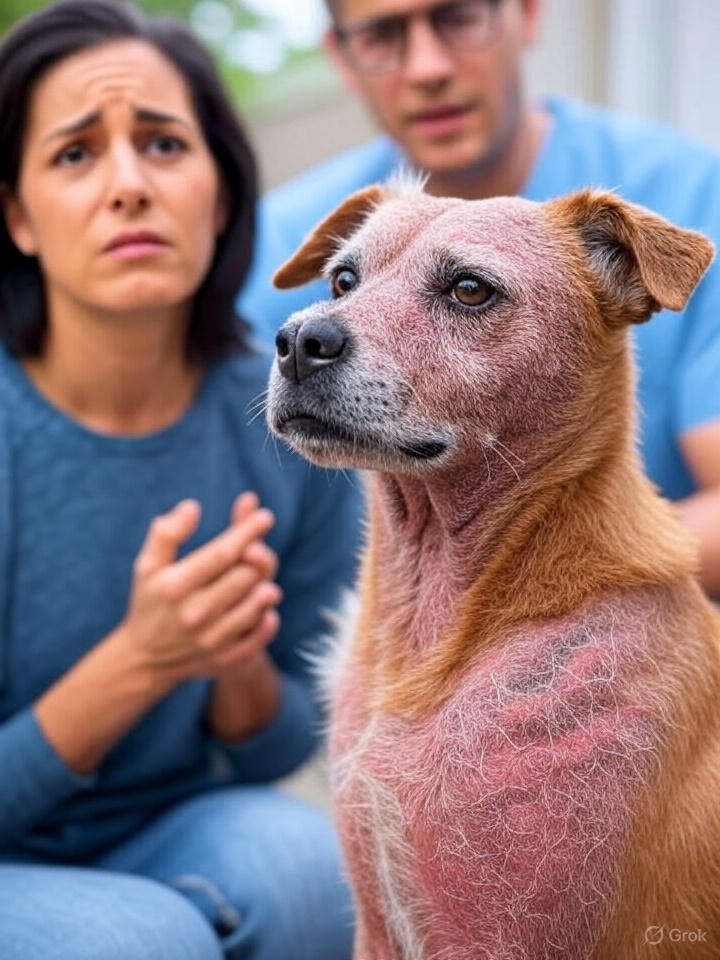
Table of Contents
Dogs that constantly scratch themselves and bite their skin may be experiencing a health issue that ranges from simple skin discomfort to dangerous medical conditions. The experience of pet pain is unbearable yet you can improve your dog’s situation by learning about potential causes and identifying symptoms while finding suitable solutions. Through this article, I will explain the causes behind dog itching and show you how to identify symptoms while offering scientific evidence-based solutions.
Why Do Dogs Itch?
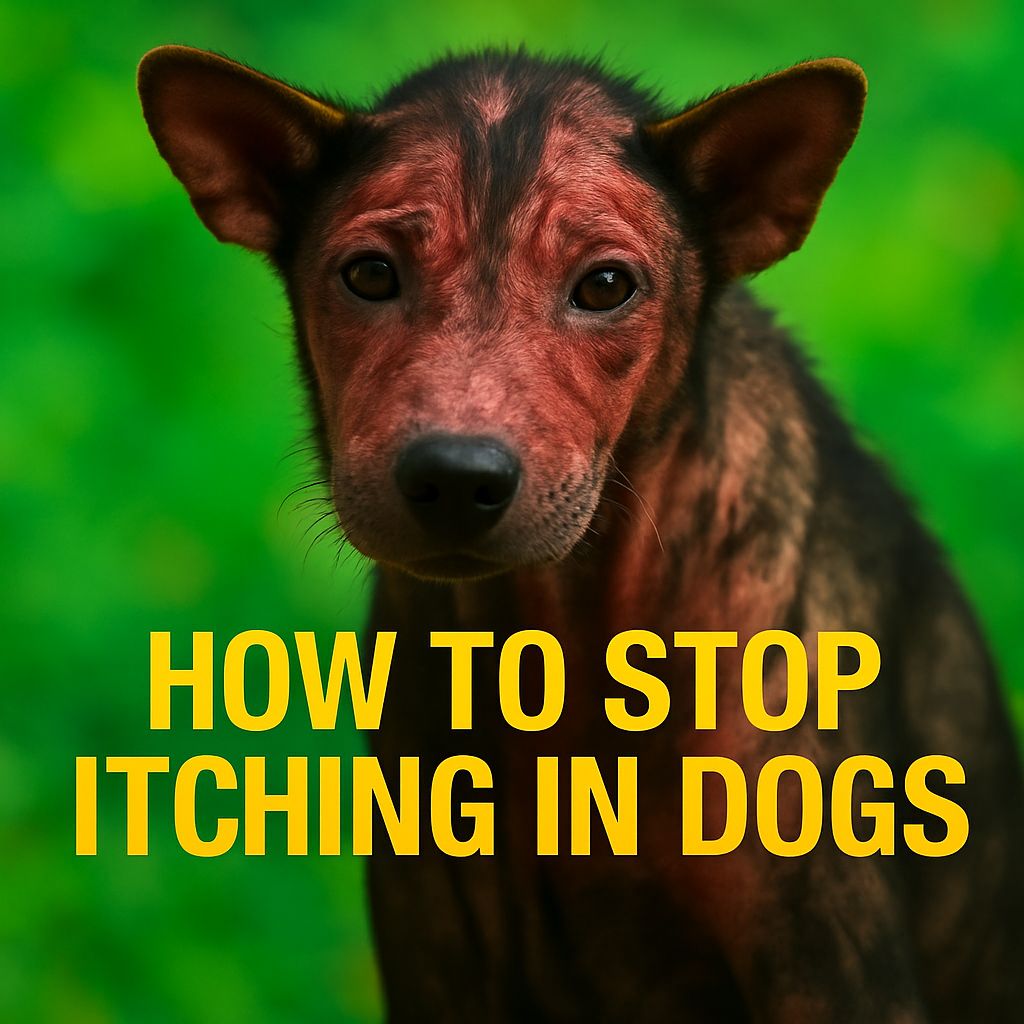
Itching in dogs represents a sensation which leads dogs to engage in scratching or biting or licking their skin. It’s not a disease itself but a symptom of something else going on. Your dog sends an SOS signal through their skin as a signal of distress. The causes can be external, like fleas crawling through their fur, or internal, like an immune system overreacting to an allergen. The key is to pinpoint the root cause to provide relief.
Each dog experiences itching for different reasons, which makes every case distinct. Different dogs experience isolated reactions to new shampoos, but many deal with persistent itching from allergies or infections. We will explore the primary causes of dog itching in this section, which will help you identify what might be causing your dog’s discomfort.
Common Causes of Itching in Dogs
Itching in dogs can be seen from several sources. Here’s a detailed look at the most common causes, along with insights to help you identify them.
1. Parasites: The Tiny Terrors
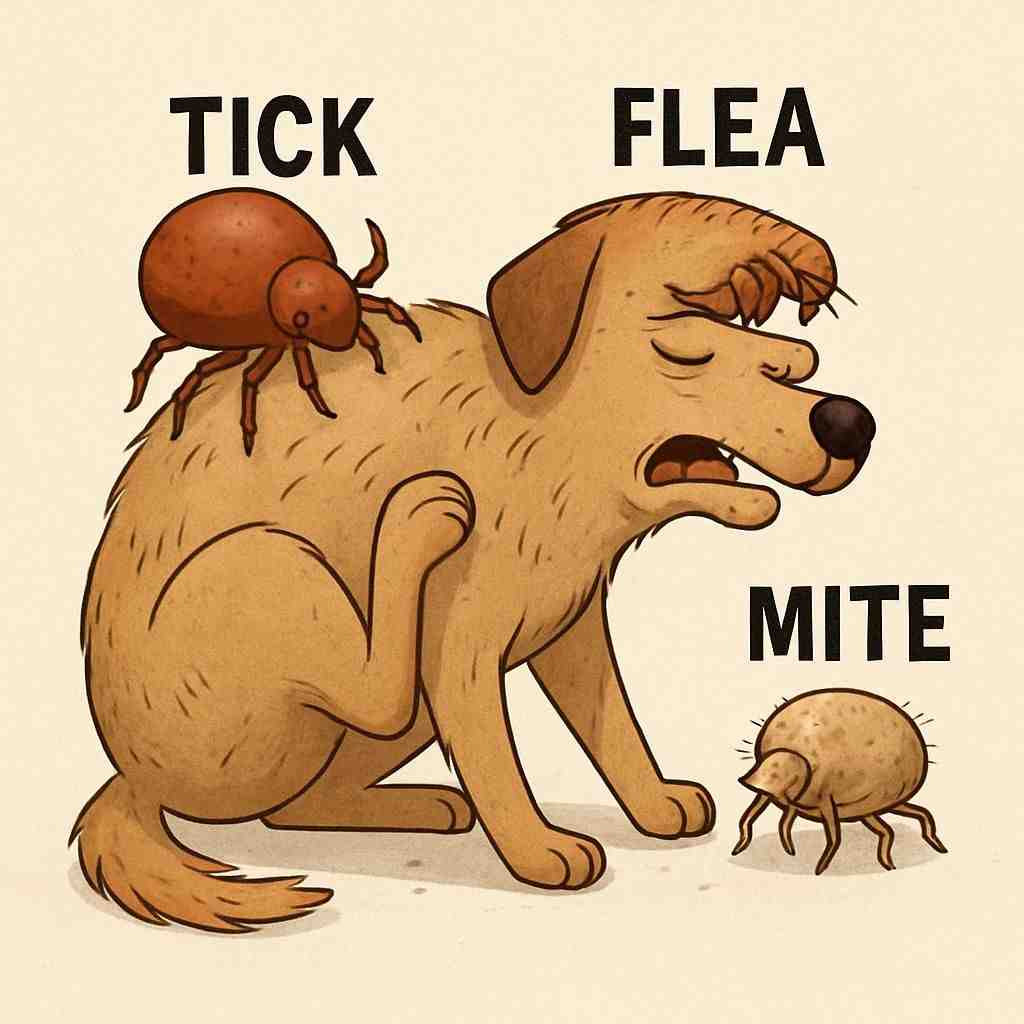
Parasites like fleas, ticks, and mites are some of the most frequent causes of itching in dogs. Fleas, for instance, don’t just bite—they leave saliva behind, which can trigger an allergic reaction in sensitive dogs. This condition, known as flea allergy dermatitis (FAD), can cause intense itching, especially around the base of the tail.
| Parasite | Example Species | Lesions / Effects on Skin | Notes / Body Areas Affected |
|---|---|---|---|
| 🕷️ Ticks | Rhipicephalus sanguineus (brown dog tick) | Red bumps at bite site, crusts, irritation, hair loss | Seen on ears, neck, between toes, under collar |
| Ixodes scapularis (black-legged/deer tick) | Redness, swelling, possible infection, tick paralysis in severe cases | Attach in hidden, warm areas (armpits, groin) | |
| 🪰 Fleas | Ctenocephalides felis (common cat flea, also affects dogs) | Intense itching, red bumps, scabs, flea allergy dermatitis, hair loss | Mostly on back, base of tail, inner thighs |
| Ctenocephalides canis (dog flea, less common) | Intense itching, red bumps, scabs, flea allergy dermatitis, hair loss | Less common than cat flea in dogs | |
| 🐛 Mites | Sarcoptes scabiei (sarcoptic mange) | Severe itching, crusts, hair loss, thickened skin, sores | Ears, elbows, hocks — can spread all over |
| Demodex canis (demodectic mange) | Patchy hair loss, scaling, redness, thick skin (not very itchy) | Face, paws, around eyes, mouth, and forelegs | |
| Otodectes cynotis (ear mite) | Dark ear discharge, head shaking, itching ears | Ear canal and around ears | |
| Cheyletiella spp. (“walking dandruff”) | Dandruff-like flakes, mild itching, redness | Back and sides — mites visible as moving flakes |
Case Study: Max, a 5-year-old Golden Retriever, was scratching relentlessly at his lower back. His owner, Som, noticed tiny black specks in his fur. A vet confirmed flea allergy dermatitis. After starting a flea control program and a short course of anti-itch medication, Max’s scratching stopped within two weeks.
2. Allergies: The Immune System Overdrive
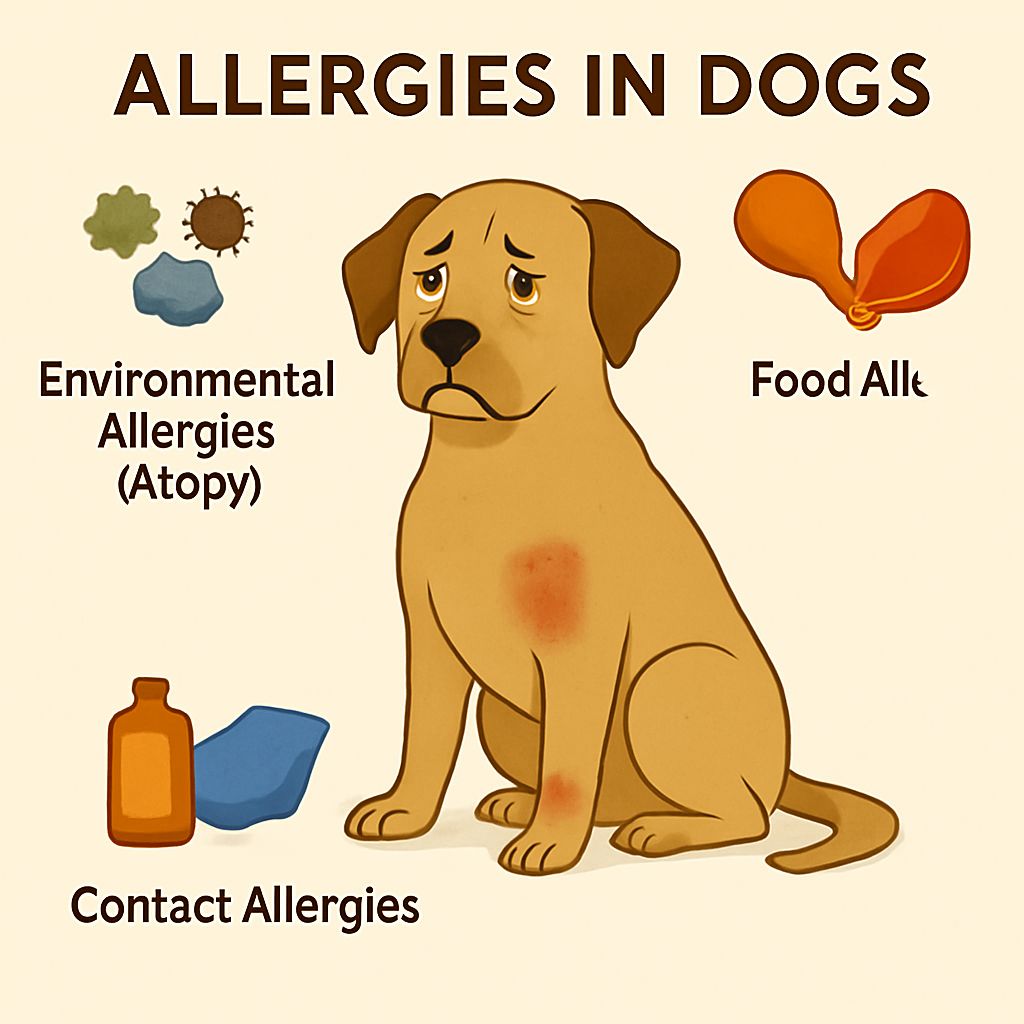
Allergies are a leading cause of chronic itching in dogs. They can be triggered by environmental factors, food, or even grooming products. Here are the main types:
- Environmental Allergies (Atopy): Pollen, dust mites, or mold can cause allergic reactions in dogs, leading to itchy skin, especially on the paws, belly, or ears.
- Food Allergies: Proteins like chicken, beef, or grains can trigger itching, often accompanied by digestive issues or ear infections.
- Contact Allergies: Certain shampoos, fabrics, or cleaning products can irritate a dog’s skin on contact.
Scientific Insight: A 2018 study in Veterinary Dermatology found that 10-20% of dogs with chronic itching have atopic dermatitis, making it one of the most common allergic skin conditions in canines.
3. Skin Infections: When Bacteria or Yeast Take Over

Bacterial or yeast infections often develop as secondary issues when a dog’s skin is already irritated from scratching. These infections thrive in warm, moist areas like skin folds or ears.
| Type of Agent | Causative Organism | Skin Condition in Dogs | Possible Source / Risk Factors |
|---|---|---|---|
| Bacteria | Staphylococcus pseudintermedius | Pyoderma (superficial or deep bacterial skin infection) | Normal skin flora that overgrows due to allergies, wounds, parasites, or immunosuppression |
| Pseudomonas aeruginosa | Hot spots (acute moist dermatitis) | Moist environments, secondary to ear infections or wounds | |
| Streptococcus spp. | Cellulitis, necrotizing fasciitis (rare) | Through wounds, bites, or severe trauma | |
| Fungi (Dermatophytes) | Microsporum canis | Ringworm (dermatophytosis) | Contact with infected animals, contaminated bedding, grooming tools, environment |
| Microsporum gypseum | Ringworm (less common) | Contact with contaminated soil or decaying organic matter | |
| Trichophyton mentagrophytes | Ringworm | Contact with rodents, soil, or infected animals | |
| Yeast | Malassezia pachydermatis | Malassezia dermatitis (yeast overgrowth) | Normal skin flora that overgrows due to allergies, moisture, or hormonal problems |
Points To Remember In Itching Of Dogs
✅ Bacteria — Often secondary to skin damage, allergies, parasites, or hormonal imbalances.
✅ Fungi — Dermatophytes (ringworm) are contagious and zoonotic, often seen in puppies or immunocompromised dogs.
✅ Yeast — Malassezia is a normal commensal, but thrives in moist, inflamed, or allergic skin.
4. Dry Skin: The Environmental Factor
Dry, flaky skin can cause itching in dogs. Causes include low humidity, frequent bathing, or poor diet lacking essential fatty acids. Breeds with thin coats, like Chihuahuas, are especially prone.
Dry Skin (Xerosis)
Dry skin in dogs occurs when the skin loses its normal moisture and oils.
This weakens the skin barrier and can lead to itching in dogs with following results:
- Cracks, flaking, and itching → Dog scratches or licks → secondary infections.
- Increased susceptibility to allergens and irritants.
- Impaired healing of minor injuries.
💧 Why does dry skin happen?
- Low humidity (especially in winter, heated indoor air).
- Frequent bathing with harsh shampoos.
- Poor nutrition (lack of omega-3 & 6 fatty acids).
- Age-related changes in skin.
Environmental Factors Role In Itching In Dogs
Environmental triggers like pollen, dust mites, humidity, or seasonal changes often worsen itching in dogs. Understanding these factors helps identify the root cause and manage your dog’s skin irritation effectively.
| Factor | How it affects the skin |
|---|---|
| 🌞 Sunlight (UV) | Sunburn in light-colored or thin-coated dogs → redness, crusts, and increased risk of skin tumors. |
| 🌡️ Temperature & Humidity | Heat & humidity → promotes bacterial/yeast overgrowth (hot spots, Malassezia). Cold & dry → causes skin dryness. |
| 🌬️ Wind & Dust | Irritates and dries skin, carries allergens that trigger atopic dermatitis. |
| 🪳 Allergens in the environment | Pollens, molds, dust mites → cause allergic skin disease (atopic dermatitis) → itching, redness, secondary infections. |
| 🧪 Chemicals & Irritants | Fertilizers, detergents, de-icing salts → contact dermatitis. |
Why do these factors lead to skin disease?
✔ They damage the skin barrier → making it more permeable to bacteria, yeast, and allergens.
✔ They trigger inflammation and itching → dog scratches → trauma → infections.
✔ Chronic exposure can lead to hypersensitivity reactions (allergies).
Brief Points
➡ Dry skin weakens the protective layer of the skin.
➡ Environmental factors (heat, cold, allergens, chemicals) stress or injure the skin.
➡ Together, they predispose dogs to infections, allergies, dermatitis, and poor healing.
5. Underlying Medical Conditions Causing Itching In Dogs
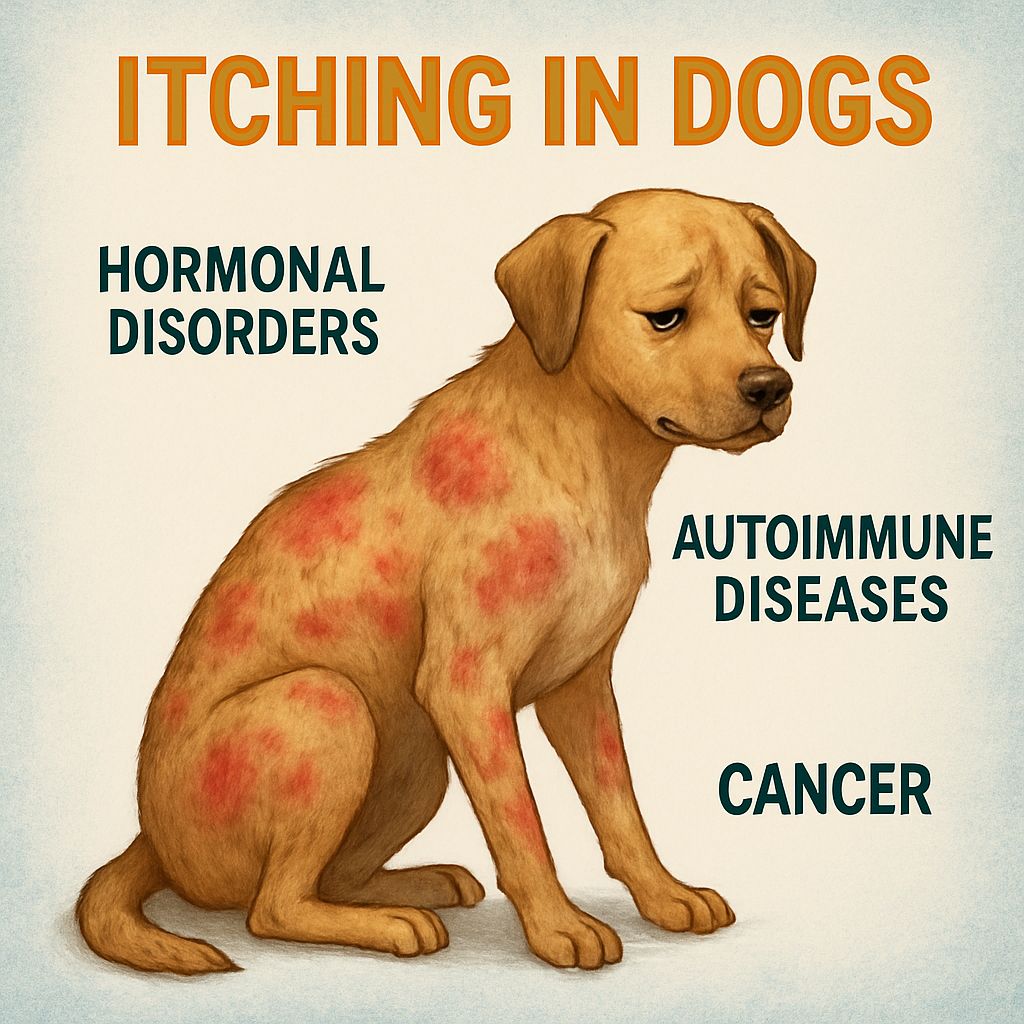
Sometimes, itching in dogs signals a deeper health issue. Hormonal disorders (like hypothyroidism or Cushing’s disease), autoimmune diseases, or even cancer can cause skin changes and itching. These are less common but should be ruled out if itching persists despite treatment.
| Cause | Example Disease | How it Affects the Skin | Notes |
|---|---|---|---|
| 🪷 Hormonal | Hypothyroidism | Dry, flaky skin, hair loss, darkened or thickened skin | Low thyroid hormone, common in middle-aged dogs |
| Cushing’s disease | Thin skin, hair loss, bruising, blackheads | Too much cortisol hormone | |
| Sex hormone imbalance | Symmetrical hair loss without itching | Usually in unspayed or unneutered dogs | |
| 🍖 Food-related | Food allergy (hypersensitivity) | Itchy skin, redness, ear infections, sometimes hives | Reaction to certain ingredients/proteins |
| 🔥 Autoimmune | Pemphigus foliaceus | Blisters, ulcers, crusts, especially on nose & ears | Immune system attacks skin |
| Discoid lupus erythematosus | Depigmentation, sores, crusts on nose and face | Worsens with sun exposure | |
| ☀️ Sun-related | Solar dermatitis (actinic dermatitis) | Red, crusty, ulcerated skin on sun-exposed areas | Seen in light-colored dogs |
| 🩹 Neoplasia (tumors) | Mast cell tumor | Lumps, ulcers, non-healing sores | Can be benign or malignant |
| Squamous cell carcinoma | Ulcerated, crusty, or warty lesions on exposed skin | Linked to sun exposure | |
| 👶 Congenital (by birth) | Ichthyosis | Very dry, thick, scaly skin from birth | Rare, genetic condition |
| Dermoid sinus | Tube-like defect under the skin, sometimes infected | Seen at birth, especially in Ridgebacks |
Keypoints
✅ These conditions are not infectious but often need long-term management.
✅ Many look similar on the skin, so diagnosis by a veterinarian is important.
Recognizing the Symptoms of Itching In Dogs
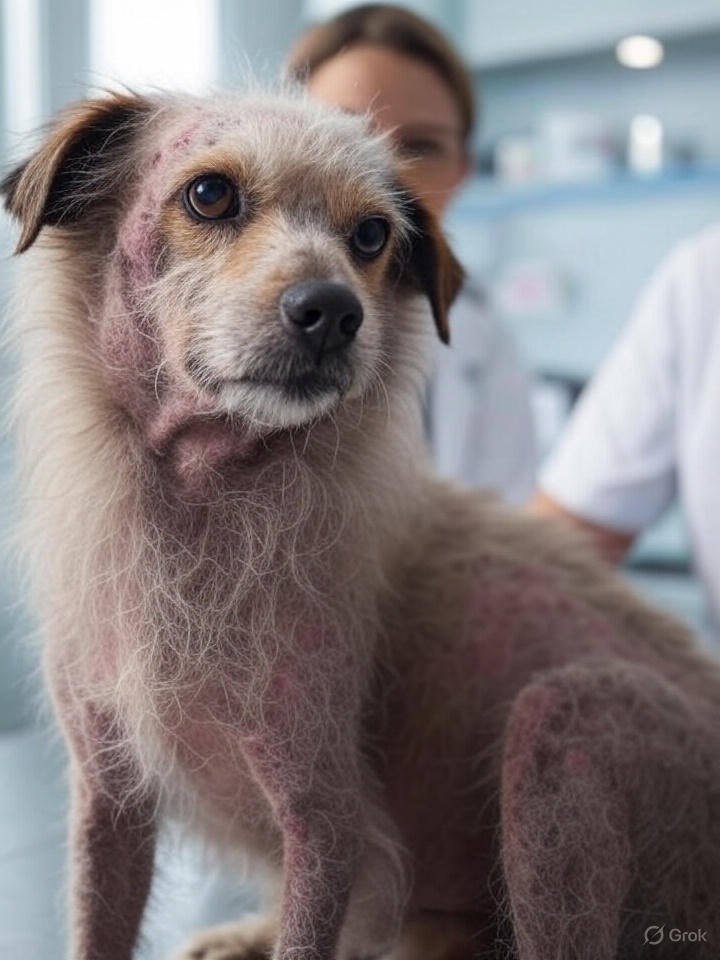
Itching manifests in ways that are hard to miss. Your dog might scratch furiously, chew their paws, or rub their face against furniture. Here are key symptoms to watch for:
| Symptom / Sign | Common Location(s) on Body | Lesions / Observations |
|---|---|---|
| Scratching and biting | Generalized or focused (neck, sides, tail base) | Redness, scabs, hair loss, broken skin |
| Chewing or licking paws | Paws, between toes | Red, moist skin, brown staining, swelling |
| Rubbing face | Around eyes, mouth, ears | Redness, hair loss, sores |
| Ear scratching & head shaking | Ears (inner and outer) | Red, inflamed ear canals, dark discharge, crusts |
| Scooting (dragging rear) | Around anus, hind end | Red, inflamed skin, possible anal gland issues |
| Hair loss (alopecia) | Patches anywhere (face, flanks, back) | Bald spots, scaling, thickened skin |
| Crusts and scabs | Ears, elbows, trunk | Crusty sores, oozing in severe cases |
| Dandruff (scaling skin) | Back, sides | Dry flakes visible on coat, mild redness |
| Thickened, darkened skin (lichenification) | Armpits, groin, belly | Thick, leathery, hyperpigmented areas |
| Hot spots (acute moist dermatitis) | Neck, hips, tail base | Wet, red, oozing sores, very painful |
| Red bumps or pustules | Abdomen, groin, chin | Small raised lesions, may rupture into scabs |
| Excessive shedding | Generalized | Thinning coat, broken hairs |
🐾 Key Notes
- Itching in dogs may be generalized or localized, depending on the cause (fleas, mites, allergies, infections).
- Common causes: fleas, mites, bacteria, yeast, food allergy, environmental allergy (atopy), or hormonal issues.
- Secondary infections often develop from constant trauma to the skin.
Bella, a 3-year-old Pitbull, started licking her paws obsessively. Her owner noticed red, swollen skin between her toes and a yeasty smell. A vet diagnosed a yeast infection secondary to environmental allergies. Treatment with antifungal shampoo and a hypoallergenic diet cleared up Bella’s symptoms.
Diagnosing the Cause of Itching In Dogs
Proper diagnosis of itching in dogs involves vet examination, skin tests, and allergy screenings. Identifying the exact cause ensures targeted treatment and long-term relief from constant scratching and discomfort.
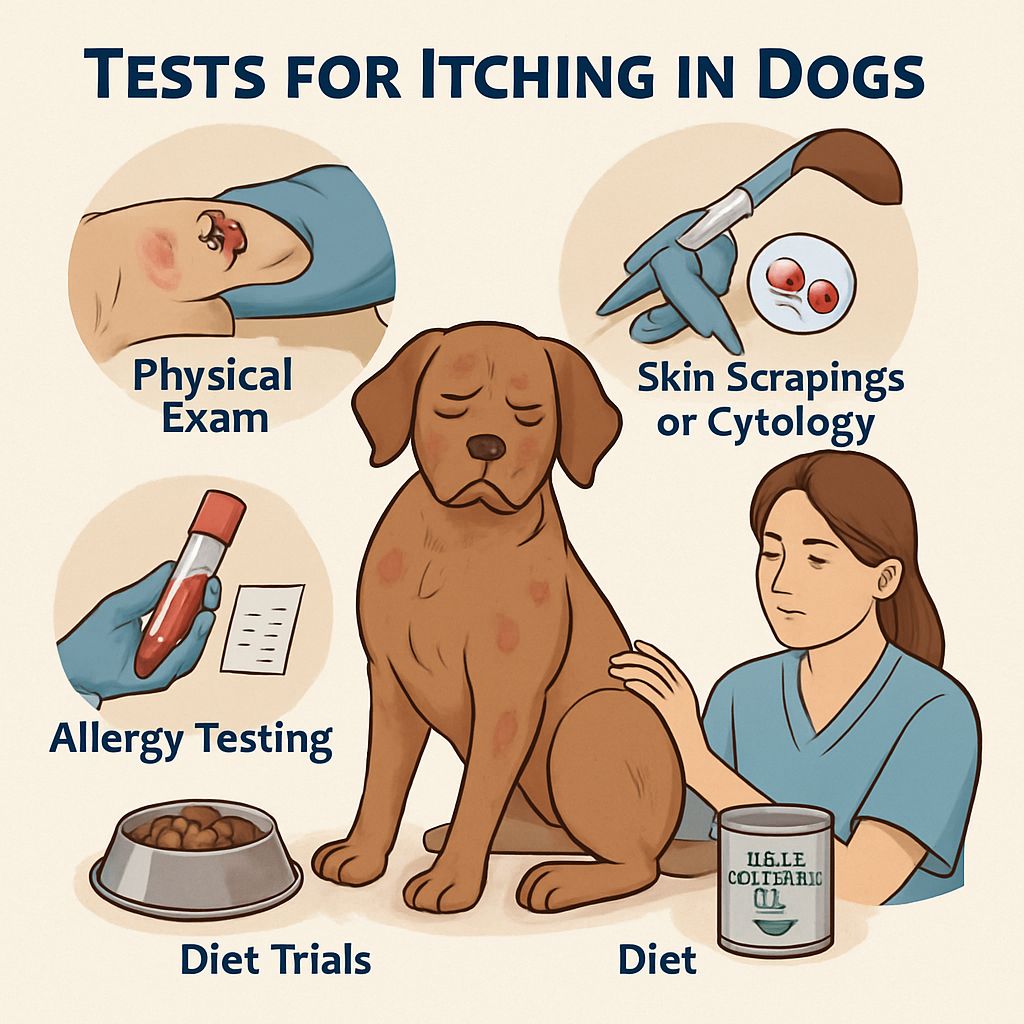
If your dog is itching more than usual, a trip to the vet is crucial. Vets use a combination of physical exams, skin tests, and history-taking to pinpoint the cause. Here’s what to expect:
- Physical Exam: The vet will check for fleas, skin lesions, or signs of infection.
- Skin Scrapings or Cytology: These tests identify mites, bacteria, or yeast.
- Allergy Testing: Blood or skin tests can confirm environmental or food allergies.
- Diet Trials: For suspected food allergies, a vet may recommend a 6-8 week trial with a novel protein diet (e.g., duck or kangaroo).
| Diagnostic Test | Brief Procedure | Used For (Conditions) |
|---|---|---|
| 🔬 Skin scraping | Gently scraping skin with a blade until mild bleeding, then examine under microscope. | Detect mites (e.g., Demodex, Sarcoptes) |
| 📄 Cytology (smears, tape) | Collect skin cells (using swab, tape, slide, or impression), stain, and view under microscope. | Bacteria, yeast (Malassezia), inflammatory cells |
| 🐛 Wood’s lamp (UV light) | Shine UV light on affected areas to check for fluorescence. | Screening for dermatophytes (ringworm – Microsporum canis) |
| 🍄 Fungal culture | Pluck hairs or take skin scrapings, place on culture medium, wait days-weeks. | Confirm dermatophytosis (ringworm) |
| 🔎 Trichogram (hair exam) | Examine plucked hairs under microscope. | Check for mites, fungal spores, hair damage |
| 💧 Allergy testing (intradermal or blood) | Inject small amounts of allergens into skin or take blood to measure antibodies. | Environmental allergies (atopy) |
| 🥩 Elimination diet trial | Feed dog a novel or hydrolyzed-protein diet for 6–8 weeks, then reintroduce old food. | Food allergies |
| 🔬 Biopsy & histopathology | Take a small piece of skin under sedation, send to lab for microscopic examination. | Autoimmune diseases, cancers, chronic conditions |
| 👂 Ear swabs & cytology | Swab ear canal, examine under microscope. | Ear infections (yeast, bacteria, mites) |
| 📸 Bacterial culture & sensitivity | Swab infected site, grow bacteria in lab, test antibiotics. | Resistant bacterial infections (deep pyoderma) |
🐾 Notes:
✅ Some tests (like skin scraping, cytology) are quick and done during the visit.
✅ Others (like cultures or biopsies) take longer but give more definitive answers.
✅ Often, more than one test is needed to pinpoint the exact cause.
Pro Tip: Keep a record of when your dog’s itching started, where they scratch most, and any recent changes (new food, bedding, or environment). This helps your vet narrow down the cause faster.
Treatment and Management: Helping Your Dog Find Relief
Treating itching in dogs depends on the cause, but the goal is always the same: stop the itch-scratch cycle and address the underlying issue. Here’s a breakdown of effective solutions:
1. Parasite Control For Itching In Dogs
- Use vet-recommended flea and tick preventatives in itching of dogs. (e.g., topical drops, oral meds, or collars).
- Treat the environment by washing bedding and vacuuming regularly to eliminate flea eggs.
2. Allergy Management
- Medications: Antihistamines, steroids, or drugs like Apoquel can reduce itching.
- Allergy Shots: For environmental allergies, immunotherapy can desensitize your dog over time.
- Diet Changes: Switching to a hypoallergenic or limited-ingredient diet can help with food allergies.
3. Treating Infections
- Bacterial infections require antibiotics, while yeast infections need antifungal treatments.
- Medicated shampoos or wipes can soothe inflamed skin and prevent recurrence.
4. Moisturizing and Nutrition
- Use vet-approved shampoos with oatmeal or aloe to hydrate dry skin to avoid itching in dogs.
- Add omega-3 fatty acid supplements to your dog’s diet to support skin health.
5. Addressing Medical Conditions
- If a hormonal or autoimmune issue is suspected, blood tests or imaging may be needed.
- Treatment may involve long-term medications or specialized care.
Scientific Insight: A 2020 study in The Journal of Small Animal Practice showed that omega-3 supplements reduced itching in 60% of dogs with atopic dermatitis when used alongside other treatments.
Home Remedies Used To Treat Itching In Dogs
Sometime for preventing itching in dogs people use different types of home made remedies.In some cases these works but in some cases it may increse the severity of infection.So it is recommended that you should contact your Vet before using any type of medication at home.
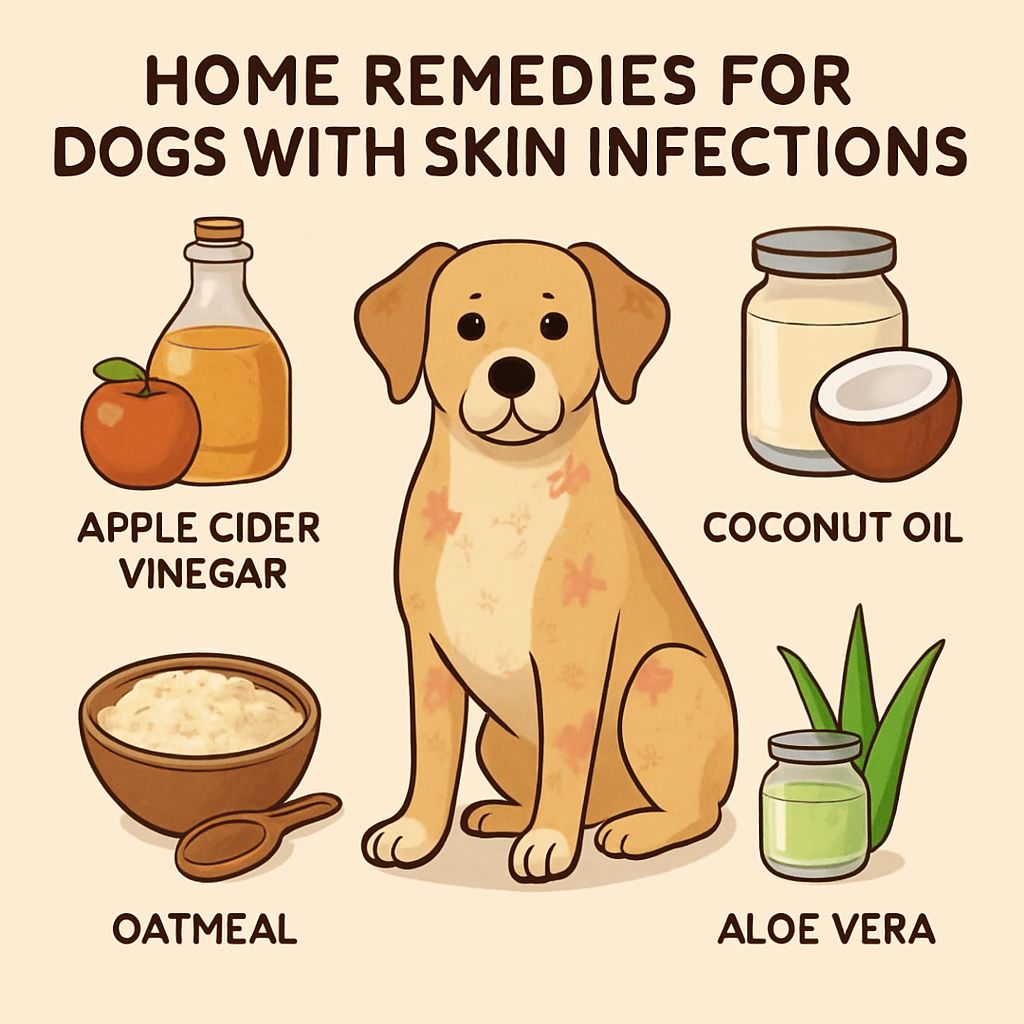
| Home Remedy | How It Helps | Is it OK for Dogs? | Possible Side Effects |
|---|---|---|---|
| 🌸 Oatmeal bath | Soothes skin, reduces inflammation & dryness | ✅ Safe for most dogs | Rare: if not rinsed well, can leave residue and cause mild irritation |
| 🧴 Coconut oil (applied on skin) | Moisturizes dry skin, mild antibacterial & antifungal | ✅ Safe in small amounts | Can make fur greasy; licking too much may cause loose stools |
| 🧊 Cool water rinse / compress | Reduces heat & itching temporarily | ✅ Very safe | No side effects; avoid ice-cold water (can shock the skin) |
| 🍎 Diluted apple cider vinegar spray (50:50 with water) | Antibacterial, antifungal, repels some parasites | ⚠️ Sometimes okay, but not on broken or raw skin | Can sting if applied to sores or irritated skin |
| 🐟 Adding omega-3 fatty acids (fish oil) to diet | Improves skin health, reduces inflammation over time | ✅ Safe if given in proper dose | Too much can cause diarrhea, weight gain |
| 🌿 Aloe vera (pure gel) | Soothes hot spots & minor irritation | ✅ Usually safe if it’s pure & dog-safe | Some aloe products have additives that are toxic; dog may lick it |
| 🛁 Regular gentle brushing & bathing | Removes allergens & loose hair, stimulates skin | ✅ Safe if done properly | Over-bathing can dry out skin; use dog-friendly shampoo only |
🐾 Tips:
✔ Always check with a vet first, especially if your dog has open wounds, severe itching, or allergies.
✔ Use remedies only as a supportive measure, not as a substitute for veterinary treatment.
✔ If symptoms persist or worsen, see a veterinarian promptly.
Preventing Itching: Proactive Steps for Dog Owners
Prevent itching in dogs through regular grooming, balanced diet, parasite control, and clean living spaces. Consistent hygiene practices and early intervention keep your dog’s skin healthy and itch-free.
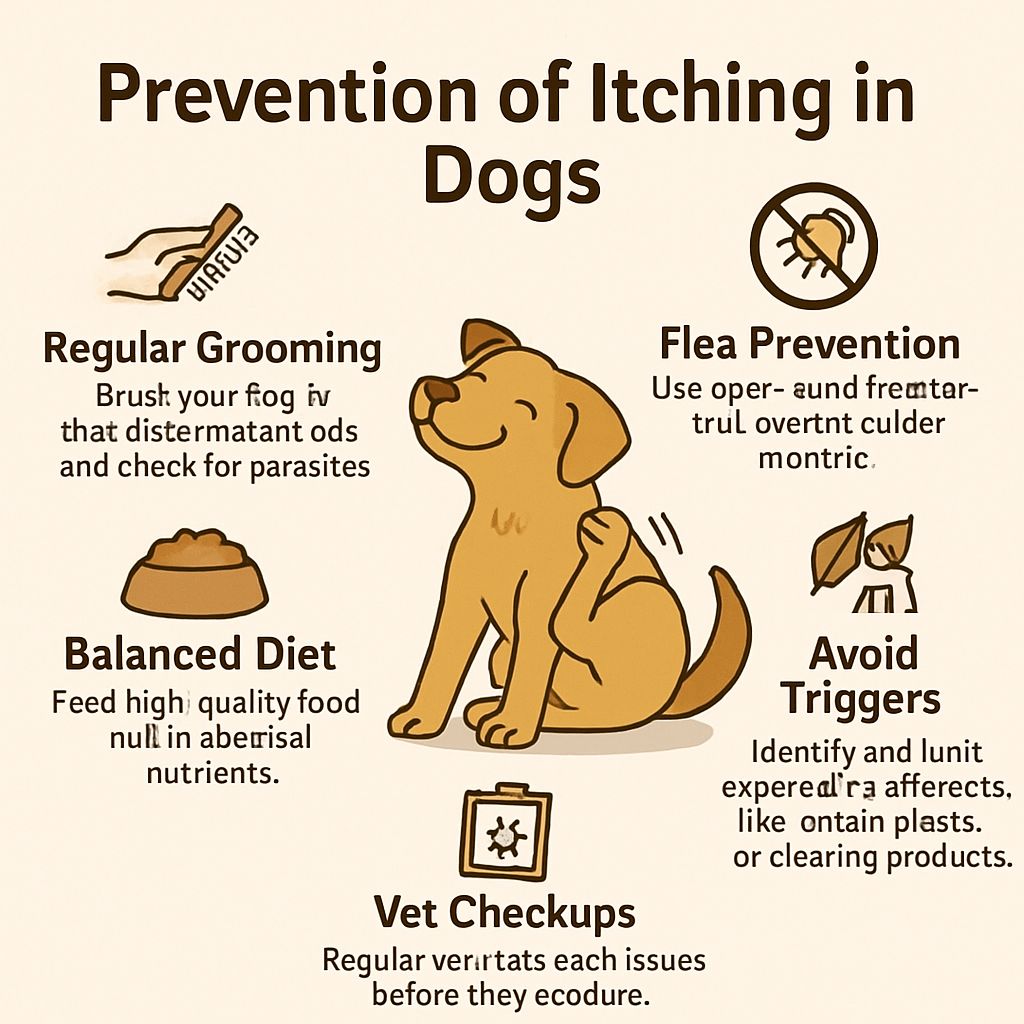
Prevention is always better than cure. Here are practical tips to keep itching at bay:
- Regular Grooming: Brush your dog to distribute natural oils and check for parasites.
- Flea Prevention: Use year-round flea control, even in colder months.
- Balanced Diet: Feed high-quality food rich in essential nutrients.
- Avoid Triggers: Identify and limit exposure to allergens, like certain plants or cleaning products.
- Vet Checkups: Regular vet visits catch issues before they escalate.
When to See a Vet In Case Of Itching In Dogs
If itching in dogs persists, causes redness, sores, or hair loss, it’s time to see a vet. Professional care ensures timely diagnosis, effective treatment, and prevention of chronic skin conditions.
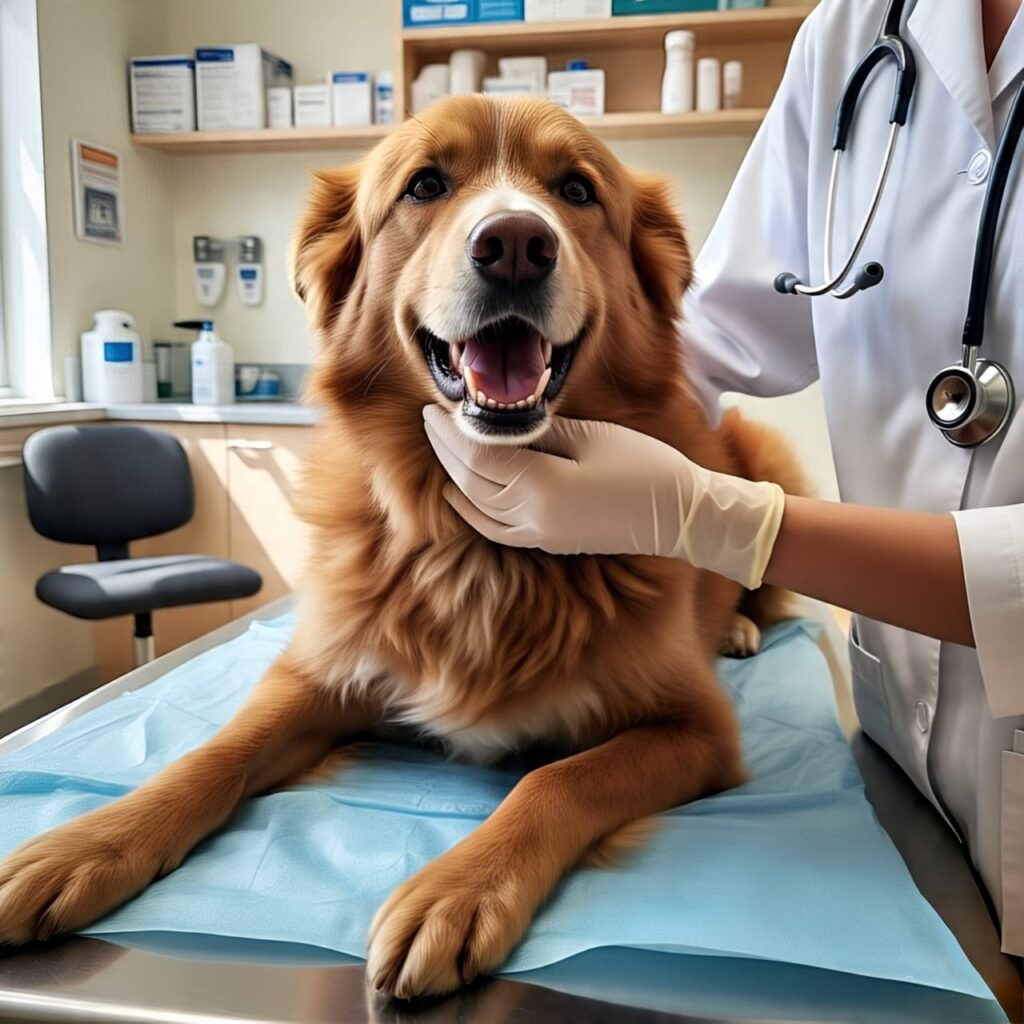
Mild itching in dogs might resolve with home care, but persistent or severe symptoms need professional attention. Contact your vet if you notice:
- Scratching that disrupts your dog’s sleep or daily activities.
- Skin changes like redness, sores, or hair loss.
- Signs of infection, such as odor or discharge.
- Behavioral changes, like aggression or lethargy.
Conclusion: A Happier, Itch-Free Dog
Itching in dogs presents a complicated problem yet remains solvable. Determining the root cause between flea infestation, allergic reaction, or infection allows for effective relief measures. Early symptom detection, along with veterinary collaboration and preventative measures, enables your dog to experience comfortable and joyful living. Your dog deserves to wag their tail freely without the need to scratch, which represents the ultimate goal. Proper care enables you to both address itching and enhance your dog’s overall life quality.
People Also Ask
1. Why is my dog so itchy but has no fleas?
Even if your dog doesn’t have fleas, they could still itch due to allergies (to pollen, dust, food), dry skin, mites, bacterial or fungal infections, or skin irritation.
2. What can I give my dog for itching?
You can give veterinarian-recommended antihistamines or prescribed medications. Do not give human medications without consulting a vet, as some can be harmful. Oatmeal baths and hypoallergenic shampoos may also help temporarily.
3. When should I take my dog to the vet for itching?
If itching in dog is severe, it causes bleeding, hair loss, sores, or your dog seems in pain, see a vet. Also go if the itching lasts more than a few days or keeps returning.
4. Can I use human antihistamines or creams on my dog?
Some human antihistamines (like Benadryl at the right dose) can be safe, but never give or apply anything without your vet’s approval, as many creams and medications are toxic to dogs.
5. What are the most common causes of itching in dogs?
- Fleas or other parasites
- Environmental allergies (pollen, dust, mold)
- Food allergies
- Skin infections (bacterial or yeast)
- Dry skin
- Contact irritation from chemicals or plants
6. Could my dog have allergies if it’s itching all the time?
Yes. Many dogs have allergies to food, grass, dust, or even certain fabrics. This is called atopic dermatitis and is one of the most common reasons for chronic itching.
7. How can I tell if my dog has a skin infection?
Signs include regarding itching in dogs:
- Red, inflamed, or oozing skin
- Foul smell
- Crusts or scabs
- Hair loss
- Your dog seems in pain or licks/chews excessively
8. What home remedies can help relieve my dog’s itching?
- Oatmeal baths
- Aloe vera (dog-safe, not flavored human gels)
- Coconut oil applied to dry patches
- Keeping the skin clean and dry
However, these may provide only temporary relief — you still need to find and treat the cause.
9. Is my dog’s itching caused by food allergies?
It’s possible. Food allergies often cause chronic itching, usually around the paws, ears, and belly, and may come with digestive problems. A vet-supervised food trial can help confirm this.
10. Can anxiety or stress make my dog itch?
Yes, some dogs lick, chew, or scratch as a nervous habit when stressed or anxious — a condition called psychogenic itching. But it’s important to rule out medical causes first.
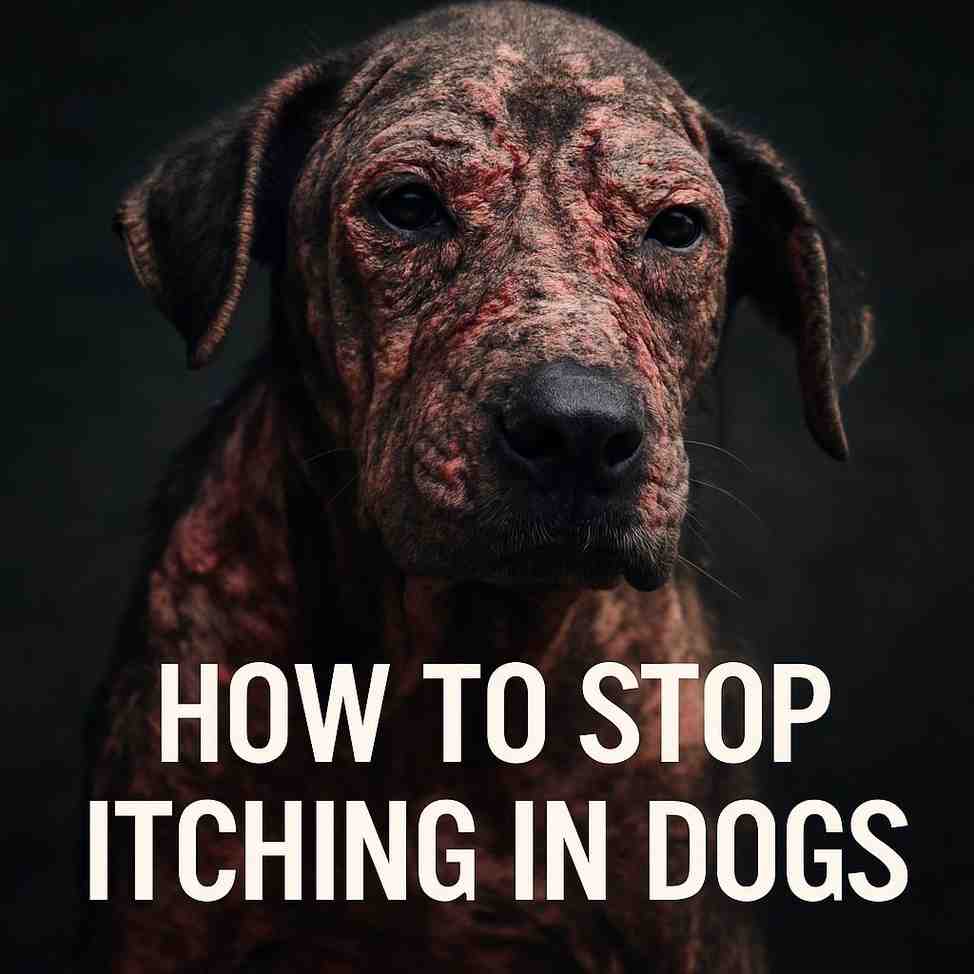
There’s definately a lot to know about this topic. I
like all of the points you made.